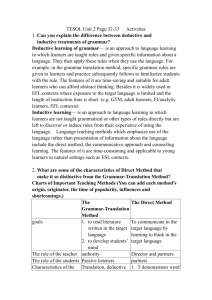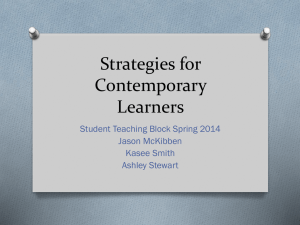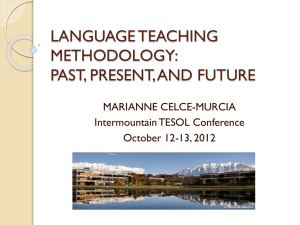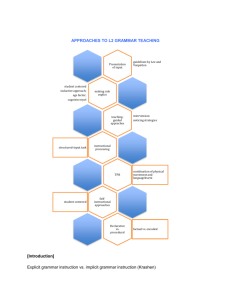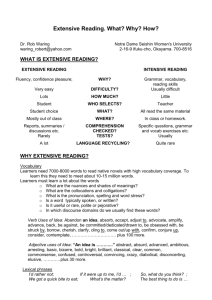Teaching a foreign language: approaches, methods and techniques
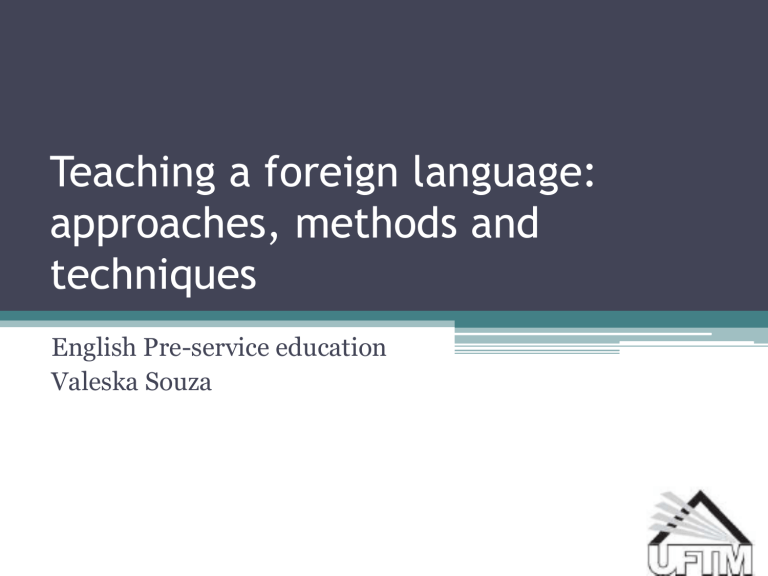
Teaching a foreign language: approaches, methods and techniques
English Pre-service education
Valeska Souza
• All cultures have their own concepts of teaching, learning and education. For aborigines , for instance, life skills are taught inductively: children learn by observing their elders , not by being lectured . For most of what is usually referred to as “western society”, or once believed to be the
“civilized world”, pedagogical actions, including foreign language learning, has been informed by methodological premises. Although the need to learn foreign languages is almost as old as human history itself, the origins of modern language education, with its approaches, methods and techniques, has its roots in the study and teaching of
Latin. In this essay, I intend to tackle some assumptions about what approach, method and technique may mean; provide a brief explanation for relevant methodology proposed by theorists; and discuss some contemporary thoughts on the subject.
• Edward Anthony (1963) has offered a model which serves as a useful way of distinguishing between different degrees of abstraction and specificity found in different language teaching proposals. He identified three levels of organization, related to the philosophy of language teaching (theory and principles) and to the procedure of teaching a language which he termed approach, method and technique. According to Anthony’s model, approach is the level at which assumptions and beliefs about language and language learning are specified; method is the level at which theory is put into practice and at which choices are made about the particular skills to be taught, the content to be taught, and the order in which the content will be presented; technique is the level at which classroom procedures are described.
• A reelaboration of Anthony’s definitions is proposed by Richards and Rodgers (1986).
According to them, a method is theoretically related to an approach, is organizationally determined by a design, and is practically realized in procedure
(classroom techniques, practices and behaviors).
Approach refers to theories about the nature of language and language learning that serve as the source of practice and principles in language teaching. Approach does not specify procedure; it is design that links them. Design comprises the objectives of the method, a syllabus model, types of learning and teaching activities, and the roles of learners, teachers and instructional materials.
• Kumaravadivelu (2008) points to some flaws in the frameworks described in the preceding paragraphs and advocates a blurring of boundaries . He claims that the tripartite models attempted to portray the entire language teaching operations as a simple hierarchical relationship among approach, method and technique, without considering the complex connection between intervening factors such as societal demands, institutional resources and constraints , instructional effectiveness and learners needs.
• Several approaches and methods of teaching languages have been widely used since “grammar schools” from the 16 th and 18 th centuries advocated the use of the Grammar Translation method for the study of Latin and later other foreign languages.
Grammar translation is a way of studying a language that approaches it first through detailed analysis of its grammar rules, followed by the application of this knowledge to translate sentences and texts. Toward the mid-nineteenth century several factors contributed to a questioning and rejection of the
Grammar Translation method.
Increased opportunities for communication among Europeans created a demand for oral proficiency in foreign languages and opened for what was termed Direct
Method. Its principles are that spoken language is primary, learners should hear language first and practice it meaningfully, grammar should be taught inductively and translation should be avoided.
• The first half of the twentieth century saw the bloom of the Oral Approach or Situational Language
Teaching in Britain and the Audiolingual Method in the United States.
Both have viewed language as a system of structurally related elements for the encoding of meaning and this structure as being at the heart of the speaking ability, the first derived from British structuralism and the latter from
American structural linguistics. Audiolingualism also draws from the behavioralist learning theory to found its proposition. In Behaviorism, the key to effective teaching is discovering the best consequence to shape the behavior. Thus, for audiolingualists, foreign or second language learning was basically a process of mechanic habit formation through memorizing dialogues and performing pattern drills.
• An approach that followed Audiolingualism and probably replaced it almost worldwide was
Communicative Language Teaching. It is a theory of language teaching that starts from a communicative model of language and language use, and that seeks to translate this into a design for an instructional system, for materials, for teachers and learner roles and behaviors, and for classroom activities and techniques. Interaction is both the means and the ultimate goal of learning a language.
• Other methodological propositions for foreign language learning came up from the mid-twentieth century up to the 1980s and I will briefly mention some. Total Physical Response is a language teaching method built around the coordination of speech and action; it attempts to teach language through physical
(motor) activity. Gattegno’s Silent Way is based on the premise that the teacher should be silent as much as possible in the classroom and the learner should be encouraged to produce as much language as possible.
Community Language Learning is a method with a humanistic approach and draws on the counseling metaphor to redefine the roles of the teacher as counselor and learners as clients in the language classroom. The Natural Approach draws from
Krashen’s theory of second language acquisition and offers a teaching proposal in which there is an emphasis in exposure, or input, rather than practice.
• I believe contemporary foreign language teaching is mostly informed by learning through communication, learner-centeredness and postmethod perspectives, and that is what I turn to now. Some approaches advocate teaching through communication rather than for it, in lessons that students use English to learn it. In content-based teaching, students learn both content from other disciplines and related language skills, building on previous knowledge and scaffolding the linguistic content. Task-based teaching offers a natural context for language use, as learners work to complete a task while having abundant opportunities to interact.
• Learning strategy training, Cooperative learning and Multiple intelligences are mainly concerned with the language learner and offer important insights to the contemporary English teachers.
Learning strategies may contribute to academic success and foster autonomy. By learning how to work cooperatively, learners can optimize building knowledge together, which may lead to distributed leadership.
Aware of Gardner’s multiple intelligences framework, teachers can account for students’ different strengths.
• Contemporary art-craft conceptions defend that teaching depends upon the teachers’ individual skill and personality. There are no general methods of teaching; rather, teachers should develop an approach with a unique set of skills that are applied in different ways according to the demands of specific situations. Kumaravadivelu’s ideas of a postmethod pedagogy would fit here. It can be visualized as a three-dimensional system consisting of the following pedagogic parameters: (a) particularity: meaningful pedagogy cannot be constructed without a holistic interpretation of particular situations; (b) practicality: there is a relationship between theory and practice; and (c) possibility: language learning is permitted and constrained by issues of power.
• All in all , I agree with Larsen-Freeman (2000) that a study of methods in invaluable in teacher education.
Methods serve as a foil for reflection that can aid us bringing to conscious awareness the thinking that underlies our actions so we are able to make informed choices. A knowledge of methods is part of a professional base of teaching and may help expand our repertoire of techniques. A multiple and consistent preservice teacher preparation including the study of language teaching methods may provide student teachers with opportunity to gain the investigative and decision making skills they need to function as responsible and autonomous teachers.

